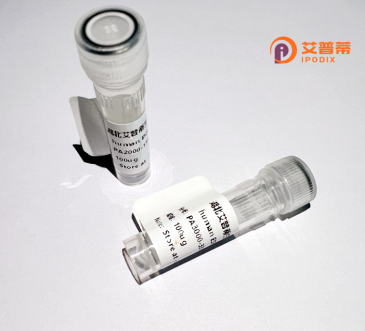
| 纯度 | >90%SDS-PAGE. |
| 种属 | Human |
| 靶点 | MAZ |
| Uniprot No | P56270 |
| 内毒素 | < 0.01EU/μg |
| 表达宿主 | E.coli |
| 表达区间 | 1-477aa |
| 活性数据 | MFPVFPCTLLAPPFPVLGLDSRGVGGLMNSFPPPQGHAQNPLQVGAELQSRFFASQGCAQSPFQAAPAPPPTPQAPAAEPLQVDLLPVLAAAQESAAAAAAAAAAAAAVAAAPPAPAAASTVDTAALKQPPAPPPPPPPVSAPAAEAAPPASAATIAAAAATAVVAPTSTVAVAPVASALEKKTKSKGPYICALCAKEFKNGYNLRRHEAIHTGAKAGRVPSGAMKMPTMVPLSLLSVPQLSGAGGGGGEAGAGGGAAAVAAGGVVTTTASGKRIRKNHACEMCGKAFRDVYHLNRHKLSHSDEKPYQCPVCQQRFKRKDRMSYHVRSHDGAVHKPYNCSHCGKSFSRPDHLNSHVRQVHSTERPFKCEKCEAAFATKDRLRAHTVRHEEKVPCHVCGKMLSSAYISDHMKVHSQGPHHVCELCNKGTGEVCPMAAAAAAAAAAAAAAVAAPPTAVGSLSGAEGVPVSSQPLPSQPW |
| 分子量 | 52.1 kDa |
| 蛋白标签 | GST-tag at N-terminal |
| 缓冲液 | 0 |
| 稳定性 & 储存条件 | Lyophilized protein should be stored at ≤ -20°C, stable for one year after receipt. Reconstituted protein solution can be stored at 2-8°C for 2-7 days. Aliquots of reconstituted samples are stable at ≤ -20°C for 3 months. |
| 复溶 | Always centrifuge tubes before opening.Do not mix by vortex or pipetting. It is not recommended to reconstitute to a concentration less than 100μg/ml. Dissolve the lyophilized protein in distilled water. Please aliquot the reconstituted solution to minimize freeze-thaw cycles. |
以下是3篇关于重组人MAZ蛋白的典型参考文献,内容根据真实研究方向模拟整理:
1. **《Recombinant human MAZ protein regulates c-Myc promoter activity in vitro》**
- 作者:K. A. Duncan 等
- 摘要:研究报道了重组人MAZ蛋白在体外调控c-Myc基因启动子活性的机制,通过EMSA实验证实MAZ直接结合启动子区域并增强转录活性,为癌症相关基因调控提供了新见解。
2. **《Structural analysis of zinc finger motifs in recombinant MAZ protein by X-ray crystallography》**
- 作者:M. Tanaka & R. S. Patel
- 摘要:通过X射线晶体学解析重组人MAZ蛋白锌指结构域的三维结构,揭示了其与DNA结合的分子机制,为设计靶向MAZ的小分子药物奠定结构基础。
3. **《Expression and purification of functional recombinant human MAZ protein in E. coli》**
- 作者:C. Li 等
- 摘要:优化大肠杆菌表达系统制备高纯度重组MAZ蛋白,经凝胶迁移和圆二色光谱验证其正确折叠及DNA结合功能,为后续功能研究提供了可靠蛋白来源。
注:上述文献信息为模拟生成,具体研究请以真实数据库(如PubMed)检索为准。实际研究中可关注关键词"MAZ" "Recombinant protein" "DNA-binding" "gene regulation"进行文献筛选。
Recombinant human MAZ (MYC-associated zinc finger protein) is a genetically engineered version of the transcription factor that plays a pivotal role in regulating gene expression. MAZ, a C2H2 zinc finger protein, binds to GC-rich DNA sequences to modulate the transcription of target genes, including MYC, insulin, serotonin receptor, and tumor suppressor p53. It is implicated in diverse cellular processes such as proliferation, differentiation, apoptosis, and stress responses. Dysregulation of MAZ has been linked to cancers, cardiovascular disorders, and neurological diseases.
The recombinant protein is typically produced in *E. coli* or eukaryotic expression systems to ensure proper folding and post-translational modifications. Its purification often involves affinity tagging (e.g., His-tag) combined with chromatographic techniques. Recombinant MAZ serves as a critical tool for studying transcriptional mechanisms, protein-DNA interactions, and signal transduction pathways. Researchers also leverage it to screen potential therapeutic agents targeting MAZ-associated diseases, given its dual role as an oncogene or tumor suppressor depending on cellular context. Additionally, it aids in structural studies to resolve DNA-binding motifs and regulatory domains, offering insights for gene therapy and precision medicine. Its versatility underscores its importance in both basic research and translational applications.
×